| Pages:
1
2 |
kazaa81
Hazard to Others
  
Posts: 368
Registered: 30-4-2004
Member Is Offline
Mood: ok
|
|
Heavy metals from eastern batteries...
Hallo to all,
from many years heavy metals like cadmium and mercury (Cd & Hg) have been banned from batteries.
Some days ago I got some chinese-asian batteries, who don't say anything about heavy metals absence or, at maximum, say low-percentage.
I would plan to extract metals from batteries (metallic Hg is nice, even only to look). How can this be done? If it is feasible, I would buy some more
asia imported batteries!
Thanks all for help 
|
|
|
chromium
Hazard to Others
  
Posts: 284
Registered: 27-6-2005
Member Is Offline
Mood: reactive
|
|
Hg was used only in certain battery types. ( even at good old times ) I do not belive those are sold nowadays anywhere expect maybe in some developing
countries.
Relatively common are rechargeable Ni-Cd batteris. I once used these to get some nickel sulfate.
I dissolved stuff from AA Ni-Cd battery in hot dilute sulfuric acid (took lot of time ) and after some evaporation and cooling nice green nickel
sulfate crystals settled out.
Liquid phase probably was mostly cadmium sulfate but i did not check this.
|
|
|
kazaa81
Hazard to Others
  
Posts: 368
Registered: 30-4-2004
Member Is Offline
Mood: ok
|
|
Hg is still used (not that much) in not great amounts in batteries where certain types of standardization hasn't come.
So, interesting metals to extract from batteries are Hg, Cd and, why not, Li.
Any information welcomed
|
|
|
hinz
Hazard to Others
  
Posts: 200
Registered: 29-10-2004
Member Is Offline
Mood: No Mood
|
|
I have opened an old NiCd batterie, and now I'm tring to convert the low soluble Cd(OH)2 at the cathode into the good solubleCd(CH3COO)2 (I have
actually no use for it, but maybe I'll get some use for it some day) by acetic acid, but the process took longer than assumed. Theoretical the
process should work fast (acid/base-reaction) but after a half a hour there where still the smell (not taste ) of acetic acid(could be the low solubility of Cd(OH)2 ) ) of acetic acid(could be the low solubility of Cd(OH)2 )
Maybe I made a misstake, but the solution did't turn green like most of the nickel salts, instead the black stuff I took gave me a black
solution, I thought the balck stuff was the cadmium hydroxide. Does anyone know if a binder is used for the Cd hydroxide, because pure Cd hydroxide
should be a white powder.
For people who want pure Cd they have to charge the batterie first since the loading process is:
2 NiO(OH) + Cd + 2 H2O (loaded)↔ 2 Ni(OH)2 + Cd(OH)2(discharged)
[Edited on 24-10-2005 by hinz]
|
|
|
The_Davster
A pnictogen
      
Posts: 2861
Registered: 18-11-2003
Member Is Offline
Mood: .
|
|
| Quote: | Originally posted by hinz
... but after a half a hour there where still the taste of acetic acid |
Wait...You are testing the presence of acetic acid in a Cadmium containing solution by taste! Cd ions are very carcinogenic. Cd ions are very carcinogenic.
|
|
|
hinz
Hazard to Others
  
Posts: 200
Registered: 29-10-2004
Member Is Offline
Mood: No Mood
|
|
Oh shit I meant smell not taste, I'm not stupid
|
|
|
Magpie
lab constructor
    
Posts: 5939
Registered: 1-11-2003
Location: USA
Member Is Offline
Mood: Chemistry: the subtle science.
|
|
I need a small amount (~1 g) of cadmium iodide. Brauer shows how to make this from cadmium sulfate. Hinz, in his 1st post above, indicates that in
the charged state a NiCd battery will have elemental cadmium. Is it possible to just cut open such a battery and extract a piece of pure cadmium?
Has anyone ever done this?
Any suggestions for a cheap OTC source of a small amount of Cd or CdSO4 are welcomed.
The single most important condition for a successful synthesis is good mixing - Nicodem
|
|
|
not_important
International Hazard
    
Posts: 3873
Registered: 21-7-2006
Member Is Offline
Mood: No Mood
|
|
| Quote: | Originally posted by Magpie
I need a small amount (~1 g) of cadmium iodide. Brauer shows how to make this from cadmium sulfate. Hinz, in his 1st post above, indicates that in
the charged state a NiCd battery will have elemental cadmium. Is it possible to just cut open such a battery and extract a piece of pure cadmium?
Has anyone ever done this? |
I did many years ago, with surplus NiCd batteries that distantly resembled lead acid batteries - not the C and D cell types.
The electrolyte is aqueous KOH, I drained that out the refilled and drain the batteries with plain water a couple of times. After that it was cracking
the cases and removing the plates, then picking which was nickel and which was cadmium. I used nitric acid to dissolve them, there was carbon mixed in
with the Cd(OH)2 and boiling with 40% acid seemed to destroy much of it.
Cadmium salts tend to be difficult to crystallise. I don't remember what I did to make sure no nickel came along, but it was all wet process stuff.
| Quote: | | Any suggestions for a cheap OTC source of a small amount of Cd or CdSO4 are welcomed. |
You may be able to find art paints that still used cadmium sulfide or selenosulfide - cadmium reds, oranges, and yellows. If it's the real cadmium
stuff there likely will be warnings on it, it's being replaced with other pigments - be warned that some paints reain the "cadmium red" colour name
without having any cadmium in them. Mix the oil paint with paint thinner or other cheap hydrocarbon solvent, let the pigment settle and drain off the
solvent, repeat several times.
Alternatively the same cadmium compounds are used for some low fire pottery stains and glazes. I've bought what turned out to be straight CdS as a
stain long ago.
If you can get any of those, hot HNO3 or HCl will dissolve the pigment. If it's a selenosulfide I would not use HCl because the Se
can come off as the chloride. Hot sulfuric acid might work as well, you may have to use concentrate acid and heat enough that it oxidises the pigment.
|
|
|
UnintentionalChaos
International Hazard
    
Posts: 1454
Registered: 9-12-2006
Location: Mars
Member Is Offline
Mood: Nucleophilic
|
|
Se coming off as the chloride? Wouldn't the fear be of H2Se, which is noxiously poisonous? Also be aware that many Cadmium red paints are probably
contaminated with BaSO4. I have some high quality stuff on me that the company claims is pure Cadmium Sulfide/Selenide (generic description of cadmium
paints), probably mostly or completely selenide since it is a deep red paint (Old stuff too....I have some tubes of real vermillion that I don't
intend to open...the stuff is somewhat rare and expensive since no company that I know of produces it anymore) I would very much like to isolate both
cadmium and selenium from the paint for the element collection (slowly coming along)
Department of Redundancy Department - Now with paperwork!
'In organic synthesis, we call decomposition products "crap", however this is not a IUPAC approved nomenclature.' -Nicodem
|
|
|
not_important
International Hazard
    
Posts: 3873
Registered: 21-7-2006
Member Is Offline
Mood: No Mood
|
|
They may have BaSO4 in them as well, especially in the paints; contaminated isn't theproper word as it is put there intentionally. But barium sulfate
is pretty stable to common acids at reasonable temperatures, so it would be left as a white solid. If all that is needed is a couple of grams of Cd,
paint may be the simplest way to go. I'd even try checking out art departments at schools, asking if they any old, dried up tubes of paint they might
have, for "analytic chemistry practice". There's a few other useful elements and compounds to be found, if you don't want more than a few grams it
can be a very low cost way to get those samples.
I always used HNO3 or that plus HCl, so it was a fairly oxidising environment. But I've read some old time qual analysis texts where selenium was
distilled out of samples where it should be present as Se(2-) by treatment with HCl, HBr, or mixes of those; the Se came over as halides.
In either case, as hydride or halide, you don't want to be breathing it.
|
|
|
Levi
Hazard to Others
  
Posts: 196
Registered: 24-1-2007
Member Is Offline
Mood: No Mood
|
|
If you intend to take apart a battery make sure you have eye protection at the very least. Some time ago, I took apart a C battery and was surprised
to find it slightly pressurized. A glob of sulfuric acid and lead powder shot out and landed harmlessly nearby, but it could have just as easily hit
me in the face.
Chemcrime does not entail death. Chemcrime is death.
|
|
|
not_important
International Hazard
    
Posts: 3873
Registered: 21-7-2006
Member Is Offline
Mood: No Mood
|
|
| Quote: | Originally posted by Levi
If you intend to take apart a battery make sure you have eye protection at the very least. Some time ago, I took apart a C battery and was surprised
to find it slightly pressurized. A glob of sulfuric acid and lead powder shot out and landed harmlessly nearby, but it could have just as easily hit
me in the face. |
That was a nice thing about the old NiCd batteries. They weren't fully sealed, there was a hole closed by a screw that was used to add make-up water.
Take the screw out, invert the battery over a bowl and let it drain, refill with water to rinse, repeat. Got ride of the KOH solution just like that.
But the newer C and D cells are sealed, so yes care should be taken as strong KOH solution is no better than sulfuric acid when it comes to having on
you.
|
|
|
Magpie
lab constructor
    
Posts: 5939
Registered: 1-11-2003
Location: USA
Member Is Offline
Mood: Chemistry: the subtle science.
|
|
Today I checked out the art paint pigments for cadmium. As previously noted there is quite a variety: cadmiumzinc sulfide also known as YP35,
cadmium/selenium sulfide, and cadmium sulfide/barium sulfide. There are also paints calling themselves "cadmium yellow" that don't have any cadmium
but an organic compound instead. I was ready to buy a tube of cadmium yellow oil paint but it was too expensive. It would be better to just buy the
Cd metal itself.
Feeling frustrated at having to wait for a shipment of Cd I decided to tear into a NiCd C cell that I had recently charged. I was a bit aphrehensive
about this due to all the warnings about possible explosions. I had a tough time just finding out how these are constructed. I finally found 2
decent documents on the Energizer web site, including a cut-away drawing. I have to say that these small cells are a marvel of technical achievement
and mass production.
Wearing eye protection and rubber gloves I locked my Panasonic C cell in my vice. I first drilled a small hole on the top to vent any pressure -
there was none. I then cut off the top (+ end) about 5-6mm down using a hack saw. When the top was off I picked at the "jelly roll" a bit with a
pair of needle nose pliers, trying to pull it out of the can. I saw 2 small red glowing "burns" which at first I thought was pyrophoric fire. Now I
think it may have been just shorting. I got very concerned about this so put the assembly in a bowl of canola oil. I then drilled a 3-4mm hole in
the bottom of the case and pushed out the jelly roll with a screw driver. I was relieved to get it out as I then felt I shouldn't have to worry about
an explosion.
The jelly roll consisted of two stiff tapes as shown below. I believe the silver one is cadmium pasted on a perforated metal support, and the black
one nickelic hydroxide pasted on a perforated metal support. Between the electrodes was a translucent white fibrous gel separator.
Comments and advice are welcomed.
[Edited on by Magpie]
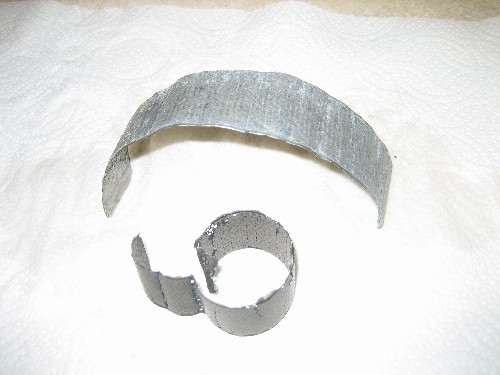
The single most important condition for a successful synthesis is good mixing - Nicodem
|
|
|
Magpie
lab constructor
    
Posts: 5939
Registered: 1-11-2003
Location: USA
Member Is Offline
Mood: Chemistry: the subtle science.
|
|
I have worked out a scheme to get fairly pure CdI2:
1. Dissolve the Cd electrode scrapings in hot 40% nitric acid.
2. Filter, retaining the filtrate.
3. Evaporate to near dryness.
4. Dissolve in 0.3N HCl.
5. Saturate with H2S forming fairly pure CdS.
6. Filter, retaining the solid CdS.
7. React with HNO3 forming Cd(NO3)2 as a solution.
8. Form Cd(OH)2 from Cd(NO3)2 per Brauer.
9. React Cd(OH)2 with H2SO4 to form solution of CdSO4.
10.Form CdI2 from CdSO4 per Brauer.
It seems I shouldn't have charged that cell. That would have taken me directly to step 9. But I don't know how pure it would have been.
Any comments or suggestions?
[Edited on by Magpie]
The single most important condition for a successful synthesis is good mixing - Nicodem
|
|
|
Magpie
lab constructor
    
Posts: 5939
Registered: 1-11-2003
Location: USA
Member Is Offline
Mood: Chemistry: the subtle science.
|
|
My cadmium project is proceeding rather slowly due to other responsibilities. However, I finally did dissolve the 10.5g of crude Cd that I scraped
from the negative plate of a charged NiCd C cell. I used 25 mL of con nitric acid, added at room temperature. The 25 mL was a stoichiometric amount.
It agressively dissolved the Cd with brown NO2 fumes profusely rolling out of the beaker (good hood required!). In retrospect I think it would have
been wiser to not add all the acid but keep just a small visible residual of Cd. This would hopefully prevent ending up with excess acid. In an
effort to remove all excess acid I just kept adding water and evaporating it off using a hot plate. When finished there was a small puddle of faintly
green liquid. I don't know where the green color came from. A test for nickel using DMG was negative.
Cd(NO3)2 is deliquescent so I never expected to see any crystals. But after sitting for 3 days crystals did form as shown below. I assume they are
Cd(NO3)2*4H2O.
[Edited on by Magpie]
[Edited on by Magpie]
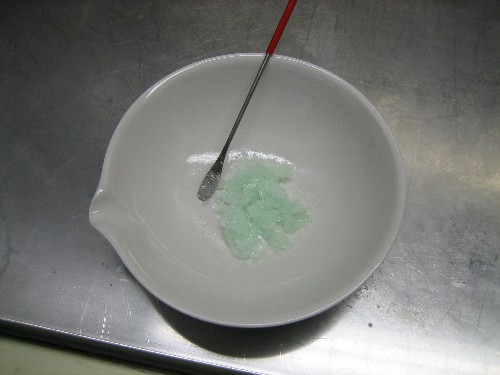
The single most important condition for a successful synthesis is good mixing - Nicodem
|
|
|
hinz
Hazard to Others
  
Posts: 200
Registered: 29-10-2004
Member Is Offline
Mood: No Mood
|
|
Are you sure that you only precipitate CdS, NiS isn't also very soluble in water, here are the solubility products:
http://www.csudh.edu/oliver/chemdata/data-ksp.htm
The cation with the lower soulubility product will precipitate first, but how did you know when NiS beginns to precipitate? I think it orks better if
you scrap the crude Cd from the charged battery as you did it.
Are Cd salts also green, it's strange the nickel test was negative, maybe the concentration of Ni is too low for the test, but this green is exactly
the nickel green.
You don't have to be afraid about explosions, I've never seen a NiCd battery exploding, there is rather the problem tht the battery will heat itself
up so much, that you can't hold it any more and the crude Cd gets oxidised to Cd(OH)2, then you can't distinguish it any more from Ni.
|
|
|
Magpie
lab constructor
    
Posts: 5939
Registered: 1-11-2003
Location: USA
Member Is Offline
Mood: Chemistry: the subtle science.
|
|
Hinz, what I plan to do is make my Cd(NO3)2 solution 0.3M in [H+] by adding 6N HCl. Then when the H2S is bubbled through the solution the [S--] will
never get high enough to precipitate out any Analytical Group III cations, which includes Ni++. This is because of equilibrium conditions for
H2S ---> <---- HS- + H+
HS- -----> <---- S-- + H+
This is the principle of separating Gp II and Gp III cations, as I understand it.
The single most important condition for a successful synthesis is good mixing - Nicodem
|
|
|
Magpie
lab constructor
    
Posts: 5939
Registered: 1-11-2003
Location: USA
Member Is Offline
Mood: Chemistry: the subtle science.
|
|
Today I made CdS by bubbling H2S through a cadmium nitrate/chloride solution 0.3 molar in H+. Precipitating the CdS was easy enough, and generating
the H2S was easy enough. The tricky part is doing it safely. I have read elsewhere on this forum that H2S is just as deadly as HCN.
The apparatus I used is shown below. I placed 5.6g of Na2S in the 250mL suction flask with 5N H2SO4 placed in the sep funnel above it. The reaction
bottle is the yellow one in the middle containing the original Cd soln and the formed CdS. The last bottle contains 100mL of ~10% NaOH to absorb
excess H2S. I did this in my hood (which is very efficient) and added the H2SO4 a drop at a time. This instantly generated H2S a few bubbles at a
time. With my hood fan on I never smelled any H2S in the lab or outside.
The most H2S I smelled was when cleaning up the glassware even though I was careful to displace all vessel freeboard with water before removing any
vessel from the hood.
I noted that some free sulfur was also formed in the tube leading into the reaction vessel and in the reaction vessel. I'm assuming that the small
amount of HNO3 present oxidized some of the H2S.
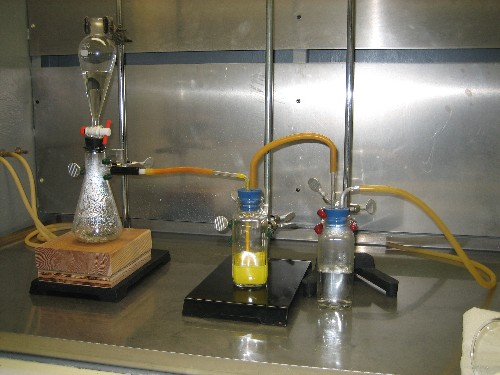
The single most important condition for a successful synthesis is good mixing - Nicodem
|
|
|
not_important
International Hazard
    
Posts: 3873
Registered: 21-7-2006
Member Is Offline
Mood: No Mood
|
|
Nice job there.
You're still likely to get a little bit of nickel tagging along, if there is much in what you originally dissolved.
dimethylglyoxime forms complexes with other metals besides nickel, the nickel complex is both highly coloured and of low solubility in water. It may
be that the high concentration of cadmium prevented formation of the nickel complex. That pale green colour sure looks like nickel or Fe(II).
|
|
|
Magpie
lab constructor
    
Posts: 5939
Registered: 1-11-2003
Location: USA
Member Is Offline
Mood: Chemistry: the subtle science.
|
|
I filtered, washed, and dried the yellow CdS, which was of very fine particle size. I dissolved 3.4g of this in an excess of 6N HNO3. I did this by
heating it on a stirrer-hotplate. It was very interesting to watch. At first nothing happened. Then as it got near boiling, all the S-- was suddenly
oxidized to elemental sulfur. It came floating to the top in one big blob. I removed this blob and washed it. In size and consistency it very much
resembles chewing gum.
I continued to boil down the Cd nitrate solution to evaporate off the excess HNO3. So what should be left is Cd(NO3)2 again. As you can see there is
no green tint this time. The sulfur blob is also shown.
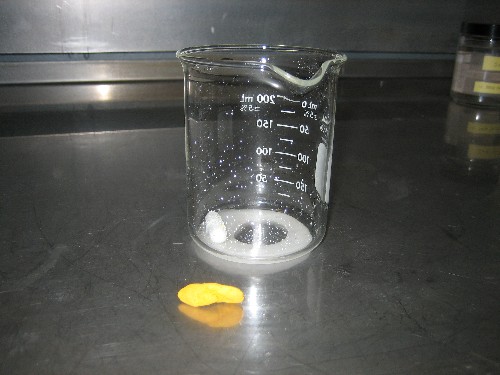
The single most important condition for a successful synthesis is good mixing - Nicodem
|
|
|
Magpie
lab constructor
    
Posts: 5939
Registered: 1-11-2003
Location: USA
Member Is Offline
Mood: Chemistry: the subtle science.
|
|
I hope my posts here aren't getting monotonous but I find the changes Cd takes with the different anions fascinating. Below is a picture of the
Cd(OH)2 formed from the Cd(NO3)2 according to method III in Brauer. Soon I will take this to CdSO4, then to the final goal of CdI2.
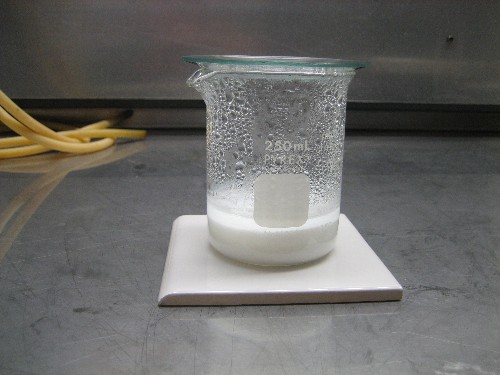
The single most important condition for a successful synthesis is good mixing - Nicodem
|
|
|
Magpie
lab constructor
    
Posts: 5939
Registered: 1-11-2003
Location: USA
Member Is Offline
Mood: Chemistry: the subtle science.
|
|
The Cd(OH)2 from above was washed and caught on a Buchner filter paper. This was then dissolved in a stoichiometric amount of dilute H2SO4. Then a
stoichiometric amount of KI was added and this was dried in an oven. The dried salts were leached with warm absolute ethanol. This was filtered,
saving the filtrate. The filtrate was then dried in an oven to remove the ethanol. The remaining crystals of CdI2 are shown in the attached photo.
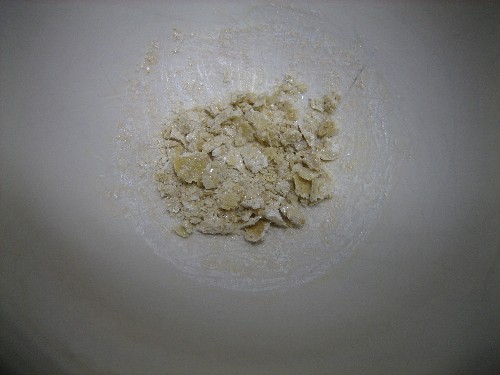
The single most important condition for a successful synthesis is good mixing - Nicodem
|
|
|
not_important
International Hazard
    
Posts: 3873
Registered: 21-7-2006
Member Is Offline
Mood: No Mood
|
|
Looks a little off colour, especially given the hydroxide being so white. Air oxidation releasing a little I2 ?
|
|
|
Magpie
lab constructor
    
Posts: 5939
Registered: 1-11-2003
Location: USA
Member Is Offline
Mood: Chemistry: the subtle science.
|
|
That could be. It was interesting that when it was being dried it seemed to go from white to light brown and back.
For color of CdI2
1. Brauer says "Colorless, lustrous, hexagonal leaflets; stable in air."
2. Lange's 10th revised ed (1952) says "brn., hex."
3. CRC 49th ed (1969) says "grn-yel powd"
It does have specks of luster as noted by Brauer.
The single most important condition for a successful synthesis is good mixing - Nicodem
|
|
|
dapper
Hazard to Self
 
Posts: 66
Registered: 8-11-2006
Member Is Offline
Mood: No Mood
|
|
Beautiful setup Magpie, Nice and Clean. Nice product!
Do you have any posts detailing construction of your bench/hood?
|
|
|
| Pages:
1
2 |